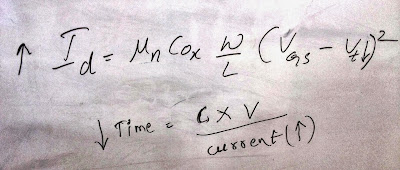A person who loves everything about electronics. I try to uncomplicate things and discover real reason behind everything we do
Friday, October 4, 2013
Temperature inversion~~cause and analysis
Let us first understand the basic concept of what causes the delay of the transistor from the below equation
fig 1. relation between current and delay of a mosfet
As you can find from the above that the more the current the less the delay of the PFET or NFET. Also you can refer to my previous blog on understanding the cell delay and transition.
Now you understand that cell delay depends on the current. Let us see what current depends on
Relation between mobility and current.
A phenomenon called lattice scattering happens at higher temperatures. Lattice vibrations cause the mobility to decrease with increasing temperature. Hence the resistance of a mosfet increases with increase in temperature causing current to reduce.
From the above figure we find that the current I is directly proportional to the mobility of the semiconductor. Hence as the mobility decreases, the current decreases. Hence cell delay increases.
So , temperature increases ==> cell delay increases duet to mobility
As , temperature decreases ==> cell delay should decrease due to mobility
Now this looks quite satisfying and this is normally the case without temperature inversion. Then what is causing temperature variation ? It is the Vt change..
Temperature and Vt variation
The threshold voltage of a mosfet decreases with increase in temperature as follows. Here (alpha Vt ) is a constant variable which denotes decreases in Vt as -3mv/degC.
Now observe that delay of your mosfet is basically dependent on two factors.
1. mobility due to temperature variation.
2. Vt varying with temperature
The final drain current would depend on what dominates the drain current at the given temperature. In practical when you decrease the temperature , you will be surprised to know that you will not be observing any temperature inversion. That is because there is one more factor of dependence which is supply voltage.
Cell delay and supply voltage
In the drain current equation (Vgs - Vt)squared , you observe that
1. when Vgs is high, (Vgs -Vt )amlost stays constant, hence your current is dependent on mobility
2. when Vgs is low, ( Vgs-Vt) difference dominates, hence your current is dependent on Vt
With all this happening all corners need to be addressed in the chip for successful functioning. Hence multi mode multi corners analysis is done before taping out the chips which is robust to catch all discrepancies.
Now you understand that cell delay depends on the current. Let us see what current depends on
Relation between mobility and current.
A phenomenon called lattice scattering happens at higher temperatures. Lattice vibrations cause the mobility to decrease with increasing temperature. Hence the resistance of a mosfet increases with increase in temperature causing current to reduce.
From the above figure we find that the current I is directly proportional to the mobility of the semiconductor. Hence as the mobility decreases, the current decreases. Hence cell delay increases.
So , temperature increases ==> cell delay increases duet to mobility
As , temperature decreases ==> cell delay should decrease due to mobility
Now this looks quite satisfying and this is normally the case without temperature inversion. Then what is causing temperature variation ? It is the Vt change..
Temperature and Vt variation
The threshold voltage of a mosfet decreases with increase in temperature as follows. Here (alpha Vt ) is a constant variable which denotes decreases in Vt as -3mv/degC.
Now put this in again in mosfet equation it becomes
Here we observe that Vgs - Vt term is squared which means that your current increases drastically with changes in Vt. Hence delay of your mosfet decreases drastically with change in Vt as the current increases significantly.
1. mobility due to temperature variation.
2. Vt varying with temperature
The final drain current would depend on what dominates the drain current at the given temperature. In practical when you decrease the temperature , you will be surprised to know that you will not be observing any temperature inversion. That is because there is one more factor of dependence which is supply voltage.
Cell delay and supply voltage
In the drain current equation (Vgs - Vt)squared , you observe that
1. when Vgs is high, (Vgs -Vt )amlost stays constant, hence your current is dependent on mobility
2. when Vgs is low, ( Vgs-Vt) difference dominates, hence your current is dependent on Vt
With all this happening all corners need to be addressed in the chip for successful functioning. Hence multi mode multi corners analysis is done before taping out the chips which is robust to catch all discrepancies.
Subscribe to:
Posts (Atom)



